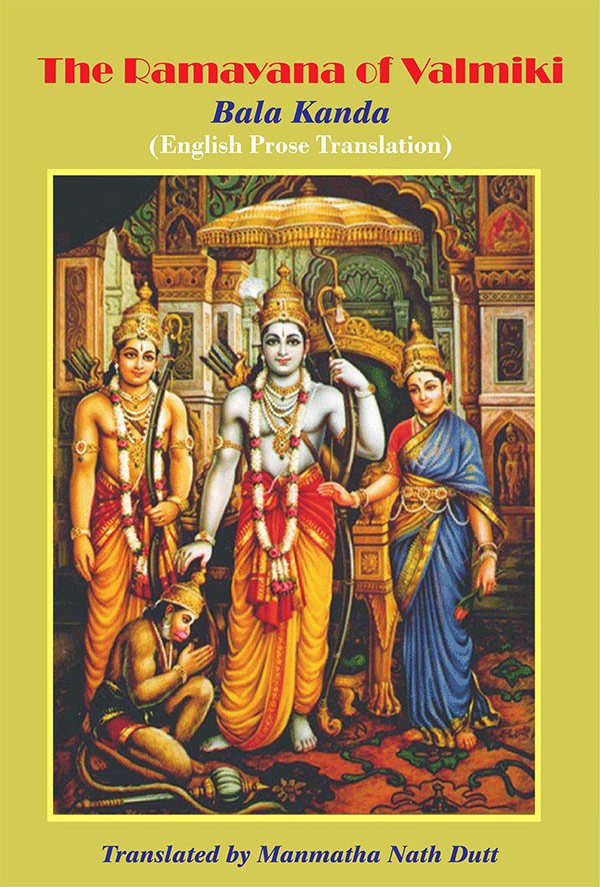Ramayana of Valmiki
by Hari Prasad Shastri | 1952 | 527,382 words | ISBN-10: 9333119590 | ISBN-13: 9789333119597
This page is entitled “ravana visits the demon marica once more” and represents Chapter 35 of the Aranya-kanda of the Ramayana (English translation by Hari Prasad Shastri). The Ramayana narrates the legend of Rama and Sita and her abduction by Ravana, the king of Lanka. It contains 24,000 verses divided into seven sections [viz., Aranya-kanda].
Chapter 35 - Ravana visits the Demon Marica once more
Hearing the words of Shurpanakha, causing his hair to stand on end, Ravana dismissed his ministers and began to reflect on what should or should not be done. Exploring the true significance of the undertaking and weighing the desirability and undesirability of the matter, he came to the conclusion ‘Thus should I act’, and, fixed in his resolve, went secretly to the splendid pavilion where his chariots were held in readiness, commanding his driver to bring out his car.
At his order, the zealous charioteer, in an instant, prepared that superb and marvellous chariot, and Ravana ascended the golden car set with gems, that coursed wheresoever he desired, to which mules in golden trappings, bearing the heads of goblins, were harnessed.
Mounted on that chariot, the wheels of which made a sound like thunder, the younger brother of Dhanada, the God of Wealth, proceeded beside the Lord of Rivers and Streams along the seashore.
Seated under a pure-white canopy with his white chanvaras, his ten heads the colour of lapis, wearing ornaments of pure gold, with ten necks and twenty arms, the younger brother of Dhanada, the enemy of the Gods, the slayer of the foremost among the ascetics, possessed of huge heads, like unto the Indra of Mountains with its ten crests, appeared beautiful, standing in his chariot, coursing at will like a mass of cloud, crowned with lightning and accompanied by a flock of cranes.
And that Great One, endowed with prowess, beheld the shores of the sea with its rocks and countless trees, laden with fruit and flowers of every kind, bordered by lakes of limpid water filled with lotuses, and spacious hermitages with their altars and groves of plantain trees lending brilliance to the scene, which was enhanced by blossoming Coconut, Sala, Tala and Tamala trees.
These places had been rendered illustrious by the presence of thousands of great Rishis of rigid penance and Nagas, Supamas, Gandharvas and Kinneras; they were rendered pleasant by Siddhas and Caranas, who were fully self-subdued and those descendants of Brahma who derived their nutriment from the solar rays and those who lived on a bare subsistence such as the Ajas, Vaikhanasas, Mashas, Valakhilyas and Marichipas. Countless nymphs of celestial beauty, adorned with garlands and jewels, beguiled them with every kind of pastime in which they excelled, and the auspicious consorts of the Gods honoured them by dwelling amongst them, whilst Danavas and other Celestial Beings who fed on Amrita frequented that place. Swans, cranes, pelicans and waterfowl disported themselves on the emerald sward, wet and shining with the sea mist; spacious cars festooned with celestial garlands from which strains of sweet music issued, flew here and there at the will of those who had conquered the worlds by their austerities, together with Gandharvas and Apsaras.
Ravana surveyed countless forests of sandalwood, whose roots were full of fragrant sap, delighting the olfactory sense, and groves of excellent Agallocha and Takkola trees with pear trees and bushes of black pepper and heaps of pearls lying on the shore, and coral reefs and gold and silver promontories, tumbling cataracts of crystal water and cities filled with grain and treasure, where the pearls of womanhood could be seen and which were thronged with horses, elephants and chariots.
On the shores of the ocean, the Lord of the Titans beheld a level and charming spot over which cool breezes blew resembling heaven itself, in the centre of which grew a great fig tree, like a bright cloud, where many sages sheltered, and on every side its branches stretched to a distance of several yojanas. It was there that the mighty Garuda brought a huge elephant and a giant tortoise in his claws, wishing to devour them among the branches, but the bough broke under the weight of that enormous bird, and the Vaikhanasas, Mashas, Valakhilyas, Marichipas Ajas and Dhumras being assembled there, Garuda had compassion on them and transported the branch together with the elephant and tortoise in one claw to a distance of one hundred yojanas, where that excellent bird regaled himself on their flesh.
Destroying the empire of the Nishadas with the severed branch, thus delivering the sages, his joy was re-doubled and his energy increased, whereupon filled with strength he resolved to steal the Nectar of Immortality. Having broken the iron bars, he entered the jewelled keep and bore away the Amrita from that place where it had been hidden by the mighty Indra.
It was this same Nyagrodha tree, frequented by groups of great sages, that still bore the marks of Supama and was called ‘Subhadra’, that the younger brother of Dhanada now saw before him.
Passing over to the further side of that Lord of the Waters, the Ocean, Ravana saw a solitary hermitage, an ancient and holy retreat in the middle of a forest. There he found the Demon Marica clad in a black antelope skin, wearing matted locks and given up to the practice of asceticism.
Ravana having approached him, Marica, according to tradition, entertained him in many ways not known to man. Placing pure food and water before his sovereign, he humbly addressed him saying:—
“Is all well with Lanka, O Chief of the Titans? With what purpose hast you come hither again so speedily?”
On hearing this enquiry, the mighty and eloquent Ravana answered in this wise:—
